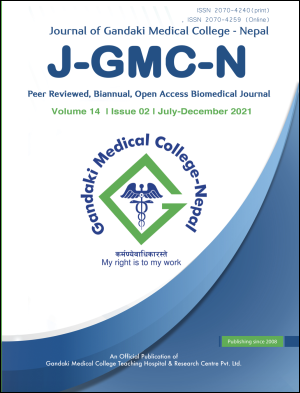Prevalence of partial edentulism among the patients visiting a Tertiary Health Care Center in the Western Region, Nepal
DOI:
https://doi.org/10.3126/jgmcn.v14i2.38719Keywords:
Applegate's modification, Kennedy's classification, partial edentulismAbstract
Introduction: Tooth loss causes impairment, functional limitation, physical, psychological, and social disability. Hence, the study of pattern of tooth loss can provide a rough information about the frequency, cause and magnitude of oral problems, its sequelae that eventually can act as mirror image of prosthodontic treatment needs.
Objectives: To assess the prevalence of partial edentulism and its etiology, to determine its association with sociodemographic parameters, and to find out the motivational factor/s for replacement in willing patients.
Methods: Total 417 patients with partial edentulism were examined intraorally on the basis of Kennedy’s classification with Applegate’s modification. The descriptive analysis was done using frequency distribution. Pearson Chi-square analysis test was used to determine the association between demographic variables and type of tooth loss where p-value ≤0.05 was considered statistically significant.
Results: Partial edentulism was more prevalent in mandibular arch (41.7%) followed by both arches (30.9%). Kennedy’s Class III was the commonest and Kennedy’s class III modification 1 was second most common type of partial edentulism. Age and educational status had statistically significant association while gender had no association with various classes of partial edentulism. Dental caries (62.8%) followed by periodontitis (25.9%) were the major causes of tooth loss. Functional demand (46.8%) was the key motivational factor for the replacement among those who were willing (78.4%).
Conclusions: This study can help in assessing the epidemiological features of partial edentulism of one community in a more classified form and can help gather information necessary to assess the treatment needs.
Downloads
Downloads
Published
How to Cite
Issue
Section
License
Copyright (c) 2021 Pratik Manandhar, Rebicca Ranjit, Sapna Laxmi Tuladhar, Arjun Bhandari

This work is licensed under a Creative Commons Attribution-NonCommercial 4.0 International License.
This license allows reusers to distribute, remix, adapt, and build upon the material in any medium or format for noncommercial purposes only, and only so long as attribution is given to the creator.




